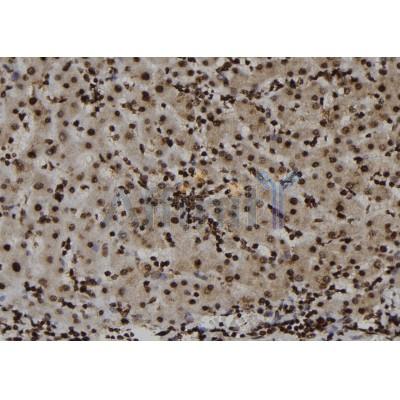Phospho-Claudin 7 (Tyr210) Antibody - #AF7453
| 製品: | Phospho-Claudin 7 (Tyr210) Antibody |
| カタログ: | AF7453 |
| タンパク質の説明: | Rabbit polyclonal antibody to Phospho-Claudin 7 (Tyr210) |
| アプリケーション: | WB IHC |
| 反応性: | Human, Rat |
| 予測: | Pig, Bovine, Horse, Sheep, Rabbit, Dog |
| 分子量: | 22kDa; 22kD(Calculated). |
| ユニプロット: | O95471 |
| RRID: | AB_2843893 |
製品説明
*The optimal dilutions should be determined by the end user. For optimal experimental results, antibody reuse is not recommended.
*Tips:
WB: For western blot detection of denatured protein samples. IHC: For immunohistochemical detection of paraffin sections (IHC-p) or frozen sections (IHC-f) of tissue samples. IF/ICC: For immunofluorescence detection of cell samples. ELISA(peptide): For ELISA detection of antigenic peptide.
引用形式: Affinity Biosciences Cat# AF7453, RRID:AB_2843893.
折りたたみ/展開
CEPTR L2; CEPTRL 2; CEPTRL2; Claudin 1; Claudin 9; Claudin-7; Claudin1; Claudin7; Claudin9; CLD7_HUMAN; CLDN 7; CLDN-7; CLDN7; Clostridium perfringens enterotoxin receptor like 2; CPETR L2; CPETRL 2; CPETRL2; Hs.84359;
免疫原
A synthesized peptide derived from human Claudin 7 around the phosphorylation site of Tyr210.
Expressed in kidney, lung and prostate. Isoform 1 seems to be predominant, except in some normal prostate samples, where isoform 2 is the major form. Down-regulated in breast cancers, including ductal carcinoma in situ (DCIS), lobular carcinoma in situ (LCIS) and invasive ductal carcinoma (IDC) (at protein level), as well as in several cancer cell lines. Loss of expression correlates with histological grade, occurring predominantly in high-grade lesions.
- O95471 CLD7_HUMAN:
- Protein BLAST With
- NCBI/
- ExPASy/
- Uniprot
MANSGLQLLGFSMALLGWVGLVACTAIPQWQMSSYAGDNIITAQAMYKGLWMDCVTQSTGMMSCKMYDSVLALSAALQATRALMVVSLVLGFLAMFVATMGMKCTRCGGDDKVKKARIAMGGGIIFIVAGLAALVACSWYGHQIVTDFYNPLIPTNIKYEFGPAIFIGWAGSALVILGGALLSCSCPGNESKAGYRVPRSYPKSNSSKEYV
種類予測
Score>80(red) has high confidence and is suggested to be used for WB detection. *The prediction model is mainly based on the alignment of immunogen sequences, the results are for reference only, not as the basis of quality assurance.
High(score>80) Medium(80>score>50) Low(score<50) No confidence
研究背景
Plays a major role in tight junction-specific obliteration of the intercellular space.
Phosphorylated.
Cell membrane>Multi-pass membrane protein. Basolateral cell membrane. Cell junction>Tight junction.
Note: Co-localizes with EPCAM at the basolateral cell membrane and tight junction.
Expressed in kidney, lung and prostate. Isoform 1 seems to be predominant, except in some normal prostate samples, where isoform 2 is the major form. Down-regulated in breast cancers, including ductal carcinoma in situ (DCIS), lobular carcinoma in situ (LCIS) and invasive ductal carcinoma (IDC) (at protein level), as well as in several cancer cell lines. Loss of expression correlates with histological grade, occurring predominantly in high-grade lesions.
Belongs to the claudin family.
研究領域
· Cellular Processes > Cellular community - eukaryotes > Tight junction. (View pathway)
· Environmental Information Processing > Signaling molecules and interaction > Cell adhesion molecules (CAMs). (View pathway)
· Human Diseases > Infectious diseases: Viral > Hepatitis C.
· Organismal Systems > Immune system > Leukocyte transendothelial migration. (View pathway)
Restrictive clause
Affinity Biosciences tests all products strictly. Citations are provided as a resource for additional applications that have not been validated by Affinity Biosciences. Please choose the appropriate format for each application and consult Materials and Methods sections for additional details about the use of any product in these publications.
For Research Use Only.
Not for use in diagnostic or therapeutic procedures. Not for resale. Not for distribution without written consent. Affinity Biosciences will not be held responsible for patent infringement or other violations that may occur with the use of our products. Affinity Biosciences, Affinity Biosciences Logo and all other trademarks are the property of Affinity Biosciences LTD.


